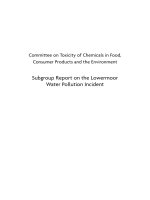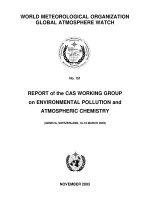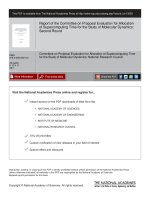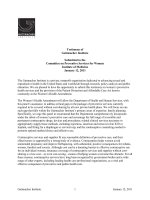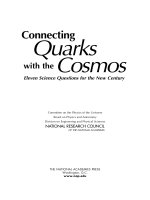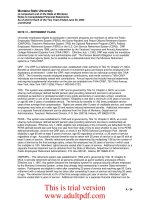Report Of The Committee On Proposal Evaluation For Allocation Of Supercomputing Time For The Study Of Molecular Dynamics pptx
Bạn đang xem bản rút gọn của tài liệu. Xem và tải ngay bản đầy đủ của tài liệu tại đây (287.41 KB, 10 trang )
Visit the National Academies Press online and register for
Instant access to free PDF downloads of titles from the
Distribution, posting, or copying of this PDF is strictly prohibited without written permission of the National Academies Press.
Unless otherwise indicated, all materials in this PDF are copyrighted by the National Academy of Sciences.
Request reprint permission for this book
Copyright © National Academy of Sciences. All rights reserved.
10% off print titles
Custom notication of new releases in your eld of interest
Special offers and discounts
NATIONAL ACADEMY OF SCIENCES
NATIONAL ACADEMY OF ENGINEERING
INSTITUTE OF MEDICINE
NATIONAL RESEARCH COUNCIL
This PDF is available from The National Academies Press at />ISBN
978-0-309-22019-4
22 pages
8 1/2 x 11
2011
Report of the Committee on Proposal Evaluation for Allocation
of Supercomputing Time for the Study of Molecular Dynamics:
Second Round
Committee on Proposal Evaluation for Allocation of Supercomputing Time
for the Study of Molecular Dynamics; National Research Council
Copyright National Academy of Sciences. All rights reserved.
This summary plus thousands more available at
Report of the Committee on Proposal Evaluation for Allocation of Supercomputing Time for the Study of Molecular Dynamics: Second Round
/>
September 16, 2011
Jodi Swidzinski Hezky, Ph.D.
D. E. Shaw Research
120 West 45th Street, 39th Floor
New York, NY 10036
Dear Dr. Hezky:
This letter describes the work and transmits the final report of the Committee on Proposal
Evaluation for Allocation of Supercomputing Time for the Study of Molecular Dynamics, Second
Round.
The committee evaluated submissions received in response to a Request for Proposals (RFP) for
Biomolecular Simulation Time on Anton, a supercomputer specially designed and built by D.E.
Shaw Research (DESRES) that allows for dramatically increased molecular dynamics simulations
compared to other currently available resources. Over the past year (October 1, 2010 – September
30, 2011), DESRES has made available to the non-commercial research community 3,000,000
node-hours on an Anton system housed at the Pittsburgh Supercomputing Center (PSC), based on
the advice of a previous National Research Council committee convened in the fall of 2010.
The success of the program has led DESRES to make the Anton machine housed at PSC available
for an additional 3,000,000 node-hours over the 9-months following October 1, 2011 and
DESRES has asked the National Research Council to, once again, facilitate the allocation of time
to the non-commercial research community. The work of the National Research Council
committee to evaluate proposals for time allocations was supported by a contract between D.E.
Shaw Research and the National Academy of Sciences and was performed under the auspices of
the National Research Council’s Board on Life Sciences.
To undertake this task, the National Research Council convened a committee of experts to
evaluate the proposals submitted in response to the aforementioned RFP. The committee of 17
was chaired by Dr. Robert L. Jernigan, Director of the Baker Center for Bioinformatics and
Biological Sciences and Professor of Biochemistry, Biophysics and Molecular Biology at Iowa
State University. The committee members were selected for their expertise in molecular
dynamics simulations, as well as their experience in the subject areas represented in the 81
proposals that were considered by the committee. They comprised a cross section of the
biomolecular dynamics field in academia, industry and government including an array of both
senior and junior investigators. The committee was assisted by two external reviewers,
1
who
1
The two external reviewers were Dr. Douglas Tobias, University of California, Irvine and Dr. Gerhard
Hummer, National Institute of Diabetes and Digestive and Kidney Diseases, National Institutes of Health.
Dr. Tobias submitted a proposal as a Principal Investigator for a time allocation on the Anton machine. Dr.
Tobias provided the committee with an initial assessment of 8 proposals and provided his feedback to the
committee only
on those proposals. He took no part in other discussions or deliberations of the committee.
Copyright National Academy of Sciences. All rights reserved.
This summary plus thousands more available at
Report of the Committee on Proposal Evaluation for Allocation of Supercomputing Time for the Study of Molecular Dynamics: Second Round
/>2
were selected to provide additional expertise in the areas of protein-lipid interactions and channel
functions and who provided the committee with an initial assessment of a subset of the proposal
submissions.
The goal of the second RFP for Biomolecular Simulation Time on Anton has been to continue to
facilitate breakthrough research in the study of biomolecular systems by providing a massively
parallel system specially designed for molecular dynamics simulations. These special capabilities
allow multi-microsecond to millisecond simulation timescales, which previously had been
unobtainable. The program seeks to continue to support research that addresses important and
high impact questions demonstrating a clear need for Anton’s special capabilities.
The Anton RFP described the three criteria against which the committee was asked to evaluate
proposals:
Scientific Merit, including the potential to advance understanding on an important
problem or question in the field; potential for breakthrough science resulting in new
discoveries and understanding; the impact that successful completion of the proposed
research would have on knowledge, methods, and current barriers in the field; and a
scientifically and technologically feasible project with clear, well-developed, and
appropriate goals, objectives, and approach to proposed studies.
Justification for Requested Time Allocation, including a clear and well-justified need
for multi-microsecond simulation timescales and a clear and convincing justification that
the length and number of proposed simulation runs and node-hours requested are
necessary and sufficient to achieve the scientific objectives.
Investigator Qualifications and Past Accomplishments, including the appropriate
experience and training to successfully conduct the proposed studies, evidence of
knowledge and prior experience in molecular simulations, and past publications.
Proposals from investigators who had previously received an allocation of time on Anton were
required to include brief progress reports. Following guidance provided by DESRES and PSC,
the committee did not use these progress reports as primary criteria but drew on them only to
supplement its consideration of proposals. As explained in the RFP, staff at PSC conducted an
initial assessment of all proposal submissions for completeness to determine whether they were
technically feasible for simulation on Anton. A member of the PSC staff was also present as an
observer throughout the review committee’s discussions to address technical specification that
arose.
In the second round of time allocations for Anton, DESRES and PSC will make time available at
two levels. In the first level, approximately 15 proposals will receive an allocation of 100,000
node-hours each. The second level will include approximately 30 proposals to receive an
allocation of 50,000 node-hours each. The committee was asked to identify proposals that best
met the selection criteria defined above for allocations at each of the two levels. The committee
was further asked to try to allocate approximately 50% of the time to investigators who did not
receive an allocation in the first round. The judgments of the committee are based on which
proposals adequately met or exceeded the selection criteria described above and on the estimates
of required simulation time provided by the applicants. The committee was also permitted to
Neither reviewer participated in the final committee discussion and assessment to achieve consensus on the
list of proposals that best met the selection criteria.
Copyright National Academy of Sciences. All rights reserved.
This summary plus thousands more available at
Report of the Committee on Proposal Evaluation for Allocation of Supercomputing Time for the Study of Molecular Dynamics: Second Round
/>3
consider a modified time allocation if it concluded that the proposed research required a greater
or lesser number of node-hours than initially requested by an applicant.
Initial reviews of the proposals were provided by the 17 committee members and the two external
reviewers. Each proposal was assigned a minimum of two primary reviewers who were asked to
evaluate the proposal based on the RFP and guidelines described above. Review assignments
were made so that no proposal was evaluated by a reviewer from the applicant’s same institution
or who had a collaborative relationship with an applicant.
The NRC committee held its 2-day meeting in Washington, D.C. on August 5-6, 2011. On the
first day of the meeting, members undertook a detailed discussion of the proposals. The two
primary reviewers were asked to summarize their review for the committee, which was followed
by discussion of the proposed research. As described in detail above, committee members
considered the scientific merit, justification of the requested time and the qualifications of the
principal investigator (PI). The discussion aimed at reaching consensus on which proposals best
met the selection criteria. The committee divided the proposals into three groups. Group 1
contained proposals that best met or exceeded the selection criteria, Group 2 contained proposals
that adequately met the selection criteria, and Group 3 contained proposals that met the selection
criteria less well than those in Groups 1 and 2. If consensus could not be reached on an
individual proposal on day 1, an additional committee member was assigned to review the
proposal in detail for discussion on the second day.
On the second day, committee members first discussed the proposals that were not easily
categorized on day 1 and obtained further details from the additional reviewer, or a primary
reviewer who had been unavailable on day 1. The committee then considered the slate of
proposals as a whole, came to a consensus on the assignment of proposals into the three groups
and, in some cases, decided to suggest a modified allocation of time on Anton.
The committee concluded that the proposals listed below best meet the selection criteria set forth
in the RFP for Biomolecular Simulation Time on Anton. Detailed comments for each of the 81
proposals are included in Appendix B.
Group 1:
The committee has identified 23 proposals that best met or exceeded the selection criteria. Of
these 23 proposals, 5 proposals were selected for a modified allocation (identified below with an
*). In numerical order by proposal submission number, these are:
PSCA10006P
Investigating protein folding and dynamics with a highly optimized
additive force field; PI: Alexander MacKerell, University of Maryland, Baltimore [New
user, identified for 50,000 node-hours]*
PSCA10018P
What are the atomistic underpinnings of molecular allostery and
signaling?; PI: David Beratan, Duke University [New user, identified for 50,000 node-
hours]*
PSCA10030P
Recognition of kinesin by microtubule during the stepping process; PI:
Devarajan Thirumalai, University of Maryland, College Park [New user, identified for
100,000 node-hours]
PSCA10031P
Mapping slow dynamical regulation of a protein kinase by combining
molecular dynamics with NMR data; PI: Susan Taylor, University of California, San
Diego [New user, identified for 50,000 node-hours]
Copyright National Academy of Sciences. All rights reserved.
This summary plus thousands more available at
Report of the Committee on Proposal Evaluation for Allocation of Supercomputing Time for the Study of Molecular Dynamics: Second Round
/>4
PSCA10038P Continued Exploration of the Human Adenovirus Protease Activation
Pathway via Long Timescale Molecular Dynamics Simulations; PI: Ross Walker,
University of California, San Diego [Returning user, identified for 100,000 node-hours]
PSCA10039P
Determining the pathway of nascent-protein insertion through the
protein-conducting channel and into the membrane; PI: Klaus Schulten, University of
Illinois, Urbana-Champaign [Returning user, identified for 100,000 node-hours]
PSCA10040P
Assessment of Multi-Microsecond Simulations of Intrinsically
Disordered Proteins Using NMR: Applications to PDX1; PI: Scott Showalter, The
Pennsylvania State University [Returning user, identified for 50,000 node-hours]
PSCA10042P
Determining Effects of HIV-1 gp41 Membrane-Spanning Domain on the
Local Composition of a Mixed Cholesterol/Lipid Bilayer using Microsecond MD
Simulation; PI: Cameron Abrams, Drexel University [New user, identified for 70,000
node-hours]*
PSCA10043P
Unraveling anomalous subdiffusion in heterogeneous membranes; PI:
Edward Lyman, University of Delaware [New user, identified for 50,000 node-hours]
PSCA10061P
The determinants of C-type inactivation and recovery in the KcsA
channel; PI: Benoit Roux, University of Chicago [Returning user, identified for 100,000
node-hours]
PSCA10062P
Using microsecond scale dynamics to characterize different classes of
allosteric interactions; PI: J. Andrew McCammon, University of California, San Diego
[Returning user, identified for 100,000 node-hours]
PSCA10066P
Molecular dynamics simulation of signal transduction in the squid
rhodopsin G-protein coupled receptor; PI: Douglas Tobias, University of California,
Irvine [Returning user, identified for 50,000 node-hours]
PSCA10067P
Dynamic coupling and fluctuations in protein-protein complexes;
PI: Matthias Buck, Case Western Reserve University [Returning user, identified for
50,000 node-hours]
PSCA10074P Chacterization of the structure and dynamics of a model two-domain
protein using multi-microsecond simulations; PI: Lillian Chong, University of Pittsburgh
[New user, identified for 50,000 node-hours]
PSCA10076P
Long time MD simulations to study large scale conformational
transitions in RNA enzymes; PI: Darrin York, Rutgers University [New user, identified
for 50,000 node-hours]*
PSCA10081P
Exploring Lipid-Protein Interactions Using Microsecond-scale
Molecular Dynamics Simulation; PI: Toby Allen, University of California, Davis
[Returning user, identified for 100,000 node-hours]
PSCA10085P
Propagation of conformational changes across a regulated catch-bond
protein; PI: Wendy Thomas, University of Washington [New user, identified for 75,000
node-hours]
Copyright National Academy of Sciences. All rights reserved.
This summary plus thousands more available at
Report of the Committee on Proposal Evaluation for Allocation of Supercomputing Time for the Study of Molecular Dynamics: Second Round
/>5
PSCA10086P Understanding the origin of high-fidelity co-translational protein
targeting: Long-timescale simulations of the Signal Receptor Particle complex; PI:
Thomas Miller, California Institute of Technology [Returning user, identified for 100,000
node-hours]
PSCA10088P
Entropy and Allostery in Protein-Ligand Binding via Simulations at the
Microsecond Time Scale; PI: Michael Gilson, University of California San Diego [New
user, identified for 100,000 node-hours]
PSCA10095P
Long Time Scale Molecular Dynamics Simulation of Protein
Folding; PI: Martin Gruebele, University of Illinois, Urbana-Champaign
[Returning user, identified for 100,000 node-hours]
PSCA10096P Computational Design and Evaluation of Novel Enzyme Catalysts; PI:
Kendell Houk, University of California, Los Angeles [Returning user, identified for 50,000
node-hours]*
PSCA10097P The effects of nonnucleoside inhibitors on the structure and dynamics of
HIV wild type reverse transcriptase and drug resistant mutants; PI: Michael Shirts,
University of Virginia [New user, identified for 50,000 node-hours]
PSCA10099P
Folding of Ribosomal Signatures and Early tRNAs; PI: Zaida
Luthey-Schulten, University of Illinois, Urbana-Champaign [New user, identified
for 100,000 node-hours]
Group 2:
The committee has identified 21 proposals that adequately met the selection criteria. Of these 21
proposals, 11 proposals were selected for a modified allocation and are identified below with an
*. In numerical order by proposal submission number, these are:
PSCA10007P
Molecular dynamics simulation study of the diffusion fence for PIP2
(phosphotidylinositol 4,5-bisphosphate) in lipid membrane; PI:Wonpil Im, The
University of Kansas [New user, identified for 50,000 node-hours]*
PSCA10008P
Simulation of the two-step mechanism for kinesin force generation in
realistic time scale: PI: Wonmuk Hwang, Texas A&M University [Returning user,
identified for 100,000 node-hours]
PSCA10014P
Understanding the role of A-tracts in eukaryotic genome organization
and their functions in transcriptional regulation; PI: George Schatz, Northwestern
University [New user, identified for 45,000 node-hours]
PSCA10017P
Investigate Hidden Intermediates in Protein Folding; PI:
Shuanghong Huo, Clark University [New user, identified for 40,000 node-hours]*
PSCA10025P Influence of ATP and ADP on conformation and dynamics of the
nucleotide-binding domain of Hsp70 chaperones; Harold Scheraga, Cornell University
[New user, identified for 50,000 node-hours]
Copyright National Academy of Sciences. All rights reserved.
This summary plus thousands more available at
Report of the Committee on Proposal Evaluation for Allocation of Supercomputing Time for the Study of Molecular Dynamics: Second Round
/>6
PSCA10029P Exploring the Membrane Selectivity and Toxicity of Antimicrobial
Peptides; Judy Kim, University of California, San Diego [New user, identified for 60,000
node-hours]
PSCA10052P
Unraveling the Structure – Dynamics – Function Relationship of Human
Histone Deacetylase 8; Peter Coveney, Yale University [Returning user, identified for
50,000 node-hours]*
PSCA10056P
Simulation and Analysis of Pressure Perturbation Dynamics of Proteins;
PI: Kim Sharp, University of Pennsylvania [New user, identified for 50,000 node-hours]
PSCA10059P
In-silico assembly of the Urel urea channel from H. pylori from helical
fragments; PI: Hartmut Luecke, University of California, Irvine [New user, identified for
50,000 node-hours]
PSCA10060P
Sequencing DNA Using MspA; PI: Aleksei Aksimentiev, University of
Illinois, Urbana-Champaign [Returning user, identified for 50,000 node-hours]*
PSCA10063P
Continuous Long-Time Dynamics of RNA Molecules: Watching without
Blinking for Microseconds through Anton’s Microscope: Extension Request; PI: Ioan
Andricioaei, University of California, Irvine [Returning user, identified for 50,000 node-
hours]*
PSCA10065P
Exploring the Gating Motions of Connexin Channels on a Microsecond
Timescale; PI: Ivaylo Ivanov, Georgia State University [New user, identified for 50,000
node-hours]
PSCA10068P
Timescale of dynamics in unfolded/unstructured proteins: microseconds
or nanoseconds?; PI: Jeetain Mittal, Lehigh University [New user, identified for 50,000
node-hours]*
PSCA10070P
Simple, Regulated Ion Channels: New Avenues for Synthetic Biology; PI:
Andrew Pohorille, University of California, San Francisco [Returning user, identified for
50,000 node-hours]
PSCA10071P
Molecular Dynamics Simulations of Conformational Dynamics in the
p38α MAP Kinase: Effects of the Apo State’s Flexibility on Inhibitor Binding Affinity;
PI: Adrian Elcock, University of Iowa [Returning user, identified for 50,000 node-hours]*
PSCA10073P
Probing allosteric regulation in the Imidazole Glycerol Phosphate
Synthase by microsecond MD simulations; PI: Victor Batista, Yale University [New
user, identified for 50,000 node-hours]*
PSCA10080P
Anton Simulations of EPAC1 to illuminate the molecular details of
cAMP based allosteric control of conformational change; PI: Thomas Woolf, Johns
Hopkins University [New user, identified for 50,000 node-hours]*
PSCA10090P
Metabolite permeation and voltage-gating of the mitochondrial channel
VDAC; PI: Michael Grabe, University of Pittsburgh [Returning user, identified for 50,000
node-hours]*
Copyright National Academy of Sciences. All rights reserved.
This summary plus thousands more available at
Report of the Committee on Proposal Evaluation for Allocation of Supercomputing Time for the Study of Molecular Dynamics: Second Round
/>7
PSCA10093P Atomistic modeling of the resting and activated states of a voltage-gated
potassium channel voltage-sensing domain; PI: J. Alfredo Freites, University of
California, Irvine [Returning user, identified for 50,000 node-hours]*
PSCA10100P
Dynamics of Calcium-Dependent Processes Essential for Cadherin
Function in Hearing and Deafness; PI: David Corey, HHMI & Harvard Medical School
[Returning user, identified for 100,000 node-hours]
PSCA10102P
Capturing Large-Scale Structural Transitions in Membrane
Transporters at Atomic Resolution; PI: Emad Tajkhorshid, University of Illinois,
Urbana-Champaign [Returning user, identified for 100,000 node-hours]
The time allocations for the 44 proposals identified by the committee as meeting or exceeding the
selection criteria for time allocations total approximately 2,890,000 node-hours. Of the 44
proposals identified, 15 were identified at the 100,000 node-hour level and 29 at the 50,000 node-
hour level.
2
A total of 1,340,000 node-hours were allocated to 23 proposals whose principal
investigator did not receive time on Anton during the past year (identified as “new users”). The
remaining 1,550,000 node-hours are allocated to 21 proposals from investigators who had
received first round time allocations (indentified as “returning users”).
After considerable deliberation, the committee has concluded that the most appropriate use of the
remaining 110,000 node-hours would be for the Pittsburgh Supercomputing Center to use its
discretion to allocate additional time to Group 1 proposals under the following guidelines:
1. No PI should be allocated more than a total of 100,000 node-hours
2. PIs may petition PSC for additional time after they have used their initial allocation
3. Preference should be given to PIs who did not receive allocations in the first round
In carrying out its task, the committee identified as many promising proposals as possible given
the constraints on the total available simulation time. The committee also encourages D.E. Shaw
Research and the Pittsburgh Supercomputing Center to establish a collective repository to share
data generated, because the trajectories obtained may be of use to other investigators in the
community.
The committee would like to thank D.E. Shaw Research, the Pittsburgh Supercomputing Center,
and all of the 2011 Anton applicants for the opportunity to assist in identifying the proposals best
meeting the selection criteria for time allocations on the Anton machine. The committee members
were universally enthusiastic about the potential advances in the field that are facilitated by Anton
and are looking forward to seeing the important new results from the Anton users.
Sincerely,
Robert L. Jernigan
Chair
cc: Dr. Markus Dittrich, Pittsburgh Supercomputing Center
Dr. Warren Muir, National Research Council
Dr. Frances Sharples, National Research Council
2
The 100,000 node-hour level is defined as proposals that were identified for 70,000 node-hours or greater.
The 50,000 node-hour level is defined as proposals that were identified for less than 70,000 node-hours.
Copyright National Academy of Sciences. All rights reserved.
This summary plus thousands more available at
Report of the Committee on Proposal Evaluation for Allocation of Supercomputing Time for the Study of Molecular Dynamics: Second Round
/>
Report of the Committee on Proposal
Evaluation for Allocation of Supercomputing
Time for the Study of Molecular Dynamics,
Second Round
Committee on Proposal Evaluation for Allocation of Supercomputing Time for the
Study of Molecular Dynamics, Second Round
Board on Life Sciences
Division on Earth and Life Studies
Copyright National Academy of Sciences. All rights reserved.
This summary plus thousands more available at
Report of the Committee on Proposal Evaluation for Allocation of Supercomputing Time for the Study of Molecular Dynamics: Second Round
/>
In Memory of
Joel R. Stiles
Whose leadership helped established this program
